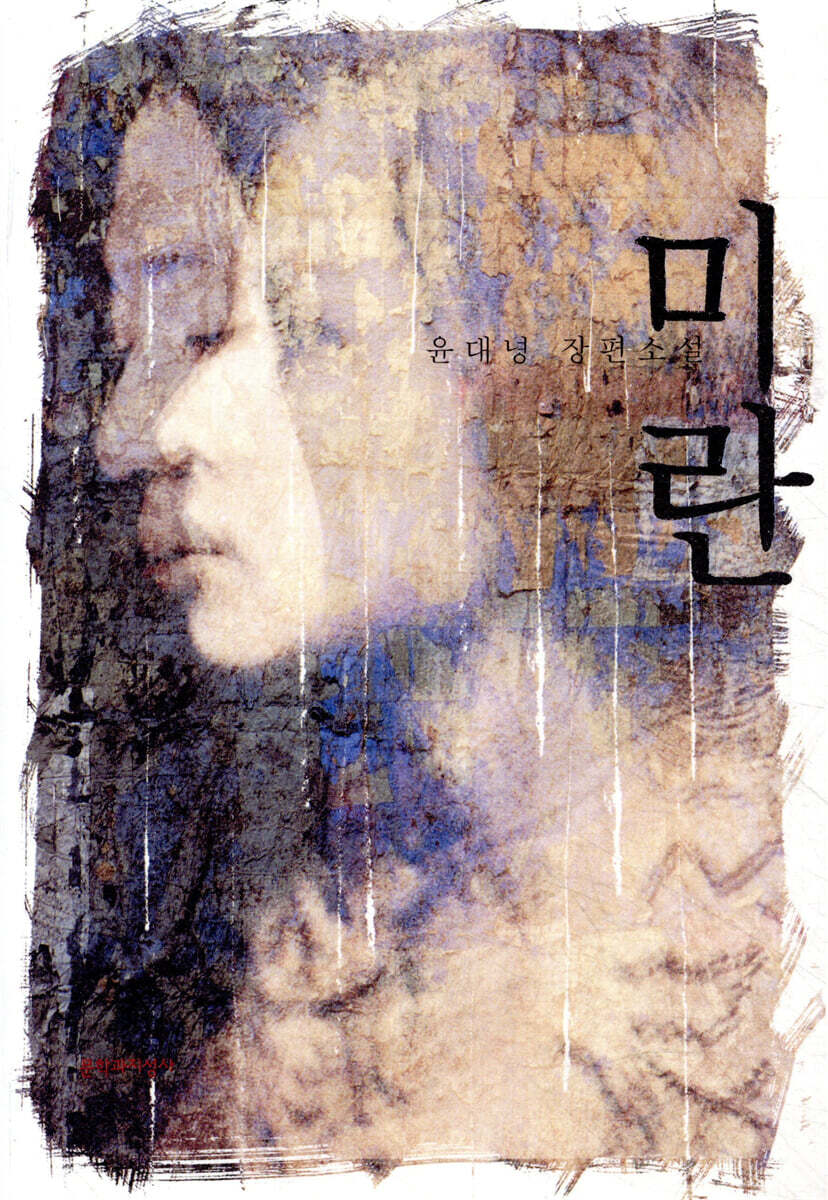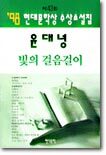Youn Dae-Nyeong (born 1962) is a South Korean writer.
Life
Youn Dae-Nyeong was born in 1962 in Yesan, South Chungcheong Province. He graduated from Dankook University with a degree in French literature. Youn's first short story, "Won" (원 Circle), was published in the Daejeon Ilbo in 1988. In 1990, his short story "Eomeoniui sup" (어머니의 숲 Mother's Forest) won the Monthly Literature & Thought's New Writer Award, completing his literary debut. He worked in publishing and PR before the publication of his first short story collection, Euno naksi tongsin (은어낚시통신 Silverfishing Memorandum), in 1994, after which he began writing full time.
Youn is the recipient of many awards including the Today's Young Artist Award (1994), the Yi Sang Literary Award (1996), the Hyundae Munhak Literary Award (1998), and the Lee Hyoseok Literary Award (2003). His major works include the short story collections Namjjok gyedaneul bora (남쪽 계단을 보라 Behold the Southern Stairs), Maneun byeoldeuri han goseuro heulleogatda (많은 별들이 한 곳으로 흘러갔다 Many Stars Drifted to One Place), Nuga goyangireul jugyeonna (누가 고양이를 죽였나 Who Killed the Cat); novels Yennal yeonghwareul boreo gatda (옛날 영화를 보러 갔다 I Went to See an Old Movie), Horangineun wae badaro ganna (호랑이는 왜 바다로 갔나 Why Did the Tiger Go to the Sea?), Pierodeurui jip (피에로들의 집 House of Clowns), and various collections of essays.
Writing
Youn Dae-Nyeong's first collection of short stories, Euno naksi tongsin, containing such works as "1993 nyeon 1 wol 9 il miaritongsin" (January 9, 1993. 미아리 통신 Dispatch from Miari, January 9, 1993), and "Soneun yeogwan euro deuleo onda gakkeum" (소는 여관으로 들어온다 가끔 Once in a While, a Cow Visits a Motel), instantly established his reputation as a writer who captures the ethos and sensibilities of Korean people during the 1990s.
The protagonists of Youn’s fiction tend to be men in their early thirties spiritually set adrift in a world of hyper-materialism. Unable to extinguish this feeling of life’s essential emptiness, they seek to recover authenticity of existence in moments of mystical or dreamlike encounters. Quite often, [this] is opened up through the mediating figure of an unfamiliar woman...providing his characters with opportunities not only to stray from the everyday reality of the present, but also to return to a deeper, more basic level of existence.[1]
Youn’s interest, however, lies less in presenting this mystical realm in its own right than
using it to hint at the deep fragmentation of his characters in the present world. A keen observer
of the details that make up the “nineties’ lifestyle,” Youn captures both the neon-light surface of
the urban terrain and the melancholy loneliness that crouches underneath in the short story
"Euno naksi tongsin." The protagonist, a freelance photographer in his thirties, lives alone in an apartment, shops in convenience stores, and enjoys listening to Billie Holiday while drinking cans of beer and having occasional “dry” sex with women who do not stay. [1]
In matters of style, Youn Dae-Nyeong is known for his aestheticism; his prose often contains poetic language studded with splendid metaphors and careful juxtapositions of striking images. At the same time, Youn also employs the fast-paced, staccato language of advertisements, reflecting in form some of his thematic concerns regarding the modern life of speed and spectacles. Further evidence of his postmodern tendencies is his hybrid approach in narrative technique. Youn draws on such varied modes of storytelling as the mystery novel and the ancient myth to heighten the reader’s engagement with the plot even when he is dealing with somewhat conceptual subject matter. [1]
References
[1] Yi, Nam-Ho, et al. Twentieth Century Korean Literature. Eastbridge Books, An Imprint Of Camphor Press, 2005. p.83-84.
Yun Dae-nyong wurde 1962 in Yesan geboren. Er war der einzige Sohn und hatte drei Schwestern. Er lebte zunächst bei seinen Großeltern und kam 1970 zu seinen Eltern, die in Onyang einen neuen Hausstand gegründet hatten. Bis er die Grundschule abschloss, hatte er mehrfach die Schule gewechselt, da sein Vater ständig umherzog. Seine Kindheit verbrachte er in Armut. Bereits im frühen Alter begann er viel zu lesen. Nach dem Abschluss seines Französisch-Studiums arbeitete er in verschiedenen Verlagen und im Pressebüro eines Unternehmens. Wenn er nicht gerade Bücher plante oder korrigierte, schrieb er in seiner Freizeit Erzählungen. 1994 erschien sein Roman Ayu-Angeln Kommunikation, in einer Zeit, da Ideologien und Totalitarismus in Korea der Vergangenheit angehörten und stattdessen das Dasein und das Individuum als Themen der koreanischen Literatur in den Mittelpunkt gerückt waren. Dieser Roman machte ihn zur Ikone der koreanischen Literatur der 90er Jahre.[2]
Su primer relato "Un círculo" (Won) se publicó en Daejeon Ilbo en 1988 y en Pensamiento literario (Munhak sasang) en 1990. Con sus siguientes trabajos, "El bosque de mi madre" (Eomma ui sup), "El memorandum del pececillo de plata" (Euno naksi tongsin), "Memorandum: Miari, 9 de enero de 1993" (1/9/93 Miari tongsin) y "De vez en cuando la vaca visita el motel" (Soneun yeogwan euro deuleo onda gakkeum), se ganó la reputación durante los noventa de ser un escritor que sabe capturar el ethos y la sensibilidad del pueblo coreano.5
En 1990 ganó el premio a nuevos escritores de la revista Munhak Sasang (Pensamiento literario). Este fue el primero de muchos, incluidos el premio al mejor artista joven actual (1994), el premio literario Yi Sang (1996), premio de literatura moderna (1998) y el premio literario Lee Hyo-seok (2003).6 Ha escrito recopilaciones de relatos cortos Ayu pescando informes, Se amontonaron muchas estrellas en un sitio y Allí camina alguien; recopilaciones de ensayos, como Las cosas que quiero decirle a ella y Los cubiertos de mi madre; y novelas como Fui a ver una película antigua, Mi-ran, una viajera en la nieve, Entre el cielo y la tierra y ¿Por qué fue el tigre al mar?.7
La première nouvelle de Yoon Dae-nyeong, Un cercle, fut publiée dans le journal Daejeon Ilbo en 1988 avant d'être republiée en 1990 dans la revue Pensée littéraire (Munhak Sasang). Avec ses récits suivants, La forêt de ma mère (Eomma-ui sup), Le courrier de la pêche des poissons argentins (Euneo naksi tongsin), Un courrier de Miari, 9 janvier 1993 (January 9 1993, Miari tongsin), Une vache vient de temps en temps au motel (Soneun yeogwan euro deureo onda gakkeum), Yoon acquiert la réputation d'un auteur qui a su capter l'esprit des années 1990 et la sensibilité des Coréens à cette époque3.
Il connaît un succès populaire à partir de l'année 1990 en remportant le prix du Nouvel écrivain décerné par la revue Pensée littéraire (Munhak Sasang). Cette récompense constitue le début d'une multitude de distinctions pour l'auteur parmi lesquelles on peut citer le prix du Jeune artiste d'aujourd'hui (1994), le prix Yi Sang (1996), le prix de littérature contemporaine (Hyundae Munhak, 1998) et le prix littéraire Yi Hyo-seok (2003)4. Il a également écrit de nombreuses nouvelles : Regarde l'escalier du sud (Namjjok gyedaneul bora), De nombreuses étoiles ont convergé vers un même endroit (Maneun byeoldeuri han-gotseuro heulleogatda), des essais comme Les choses que je souhaite lui dire (Geunyeo-ege yaegihaejugo sipeun geotdeul), Les cuillères et les baguettes de ma mère (Eomeoni-ui sujeo), ainsi que des romans Je suis allé voir un vieux film (Yennal yeonghwareul boreogatda), Miran (Miran), Un voyageur dans la neige (Nunui yeohaengja), Entre terre et ciel (Cheonjigan), et Pourquoi le tigre est-il allé à la mer ? (Horang-ineun wae badaro ganna)4.
1962年 5月1日 、忠清南道礼山郡に生まれる。1988年、大田日報新春文芸に『원(円)』が当選し、1990年に短編『어머니의 숲(母の森)』が『문학사상(文学思想)』新人賞を受賞して文壇デビューした。
「存在の始原に対する懐かしさ」という真摯な問題意識とともに、精製された詩的文体で文学的立地を固めてきた。尹の小説のひとつの特徴は「偶然性」である。頻繁な偶然の旅行、偶然の出会いなどはやはり根源の探索と永遠回帰というテーマと関連がある。このテーマは人間の原初的な無意識と関連があるが、無意識は偶然を通じてたどり着ける領域であるためだ。
もう一つの特徴は神秘的な文学世界だ。深い無意識や時間の境界を越えた空間まで小説の中に登場している。最近は「人々の様々な出会い」について描いた作品も発表している。
尹は勉強と旅行が好きな作家として知られている。小説を書くために神話や宗教書籍はもちろん、物理学や民族学の本を読んだり、小説の中の場所を直接訪れたりもしている。
윤대녕(1962~)은 대한민국의 소설가다.
생애
윤대녕은 1962년 충청남도 예산에서 태어났다. 유년시절엔 조부모와 살다가 1970년, 온양에 살던 부모에게로 왔다. 초등학교를 마칠 때까지 여러 차례 전학한 후 대전에서 중고교를 마쳤다. 1981년 단국대학교 불문학과에 문예장학생으로 입학, 1988년 졸업과 함께 도서출판 둥지, 기업체 홍보실과 범조사, 미래사 등 여러 출판사에서 근무하였다.
1988년 《대전일보》에 〈원(圓)〉(1988)이 당선되고, 1990년 단편 〈어머니의 숲〉(1990)으로 《문학사상》 신인상을 받으면서 작품 활동을 시작했다. 이후 단편 〈그를 만나는 깊은 봄날 저녁〉(1991), 〈소는 여관으로 들어온다 가끔〉(1993) 등을 발표하며 1990년대 문단의 새로운 경향을 주도했다. 1994년 첫 소설집 《은어낚시통신》이 나온 뒤, 직장을 그만두고 전업 작가의 길로 들어섰다. 동덕여대 문예창작과 교수로 일하고 있다.
작품 세계
윤대녕은 문학성의 회복을 요구하는 1990년대적 시대정신에 어울리는 작가로, 그의 작품세계는 ‘존재의 근원에 대한 탐구’로 요약된다. 1980년대의 획일적인 인간관을 거부하며, 소설적 화두를 ‘사람’으로 삼고 독특한 구성과 미학적인 문체를 통해 시대와 제도가 어떻게 갈등하고 화해하는가를 작품의 주제로 삼아왔다.
그의 소설들은 이념적 요인에 의해 크게 좌우되던 1980년대 소설과는 달리 급격한 개방과 정치적인 변동으로 치닫는 시대 상황과 특이한 관계를 유지하게 된다. 그의 작품들은 소설의 서사적 기법이 소설의 주제를 넘어서서 하나의 미학으로 자리 잡아가는 과정을 보여주고 있다.
작가의 첫 소설집 《은어낚시통신》(1994)은 10편의 단편이 수록되어 있는 소설집으로, 출간 당시 도시적 감수성과 신선한 문체로 독자와 평단의 주목을 동시에 받으며 베스트셀러를 기록했다. 이 작품은 바다에서 강으로 거슬러 올라가는 은어의 이미지와 진정한 삶을 향해 거슬러 올라가는 사람의 모습을 겹쳐놓는다. 세속적인 태도와 허위에서 벗어나 본래의 자신으로 돌아가려는 행위 속에서 삶의 가능성을 모색하고 있다.
장편소설 《옛날 영화를 보러 갔다》(1995)는 현실과 환상을 넘나드는 추리적 구성, 수수께기 같은 인물들의 등장, 섬세하면서 시적 이미지를 통해, 사회와 가정에 적응하지 못하고 회귀를 꿈꾸는 주인공의 삶을 그린 작품이다.
《삐에로들의 집》(2016)은 본래의 얼굴을 잃은 채 거짓된 표정으로 살아가고 있는 사람들과 언제나 진정한 정체성을 갈망하는 우리, ‘피에로’들에 관한 이야기이다. 작가는 가족의 해체, 그리고 삶의 기반을 상실한 채 도시 난민으로 살아가는 사람들의 이야기를 통해 유대가 붕괴된 곳에서 연대가 가능한지 모색하고 있다.
소설집 《누가 고양이를 죽였나》(2019)는 2015년 여름부터 2018년 가을호에 발표한 단편 8편을 수록한 작품집으로, 2014년 4월 세월호 참사 이후 죽음에 관련된 이야기들을 묶었다. 각각의 작품에는 래프팅 사고로 죽은 딸과 여객선 침몰로 세상을 떠난 사람들, 6년 넘게 식물인간으로 지내다 세상을 뜬 삼촌, 한곳에 머물지 못하고 떠돌아다니다 갑작스러운 죽음을 당한 연인 등 다양한 죽음과 애도의 이야기가 담겨있다.
주요 작품
1) 소설집
《은어낚시통신》, 문학동네, 1994(개정판, 2010)
《남쪽 계단을 보라》, 문학동네, 1995(개정판, 2013)
《코카콜라 애인》, 세계사, 1999.
《많은 별들이 한곳으로 흘러갔다》, 생각의나무, 1999(개정판, 문학동네, 2010)
《장미창》, 작가정신, 1998(개정판, 2011).
《누가 걸어간다》, 문학동네, 2004.
《제비를 기르다》, 창비, 2007.
《대설주의보》, 문학동네, 2010
《도자기 박물관》, 문학동네, 2013.
《누가 고양이를 죽였나》, 문학과지성사, 2019.
2) 장편소설
《옛날 영화를 보러 갔다》, 문학동네, 1995(개정판, 2008).
《추억의 아주 먼 곳》, 문학동네, 1996.
《달의 지평선》(1~2), 해냄, 1998.
《사슴벌레여자》, 자음과모음, 2001.
《미란》, 문학과지성사, 2001
《눈의 여행자》, 랜덤하우스코리아, 2003
《호랑이는 왜 바다로 갔나》, 문학동네, 2005
《삐에로들의 집》, 문학동네, 2016.
3) 산문집
《열두 명의 연인과 그 옆 사람》, 자음과모음, 2004.
《이 모든 극적인 순간들》, 푸르메, 2010.
《사라진 공간, 되살아나는 꿈들》, 현대문학, 2014.
수상 내역
1994년 오늘의 젊은 예술가상
1996년 제20회 이상문학상
1998년 제43회 현대문학상
2003년 제4회 이효석문학상
2007년 제1회 김유정문학상
2012년 제19회 김준성문학상





